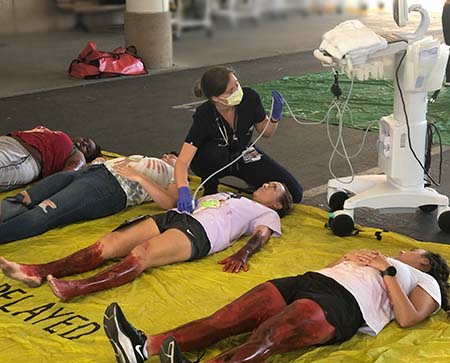Disaster exercise tests emergency department's preparedness
Over 100 staff members and volunteers took part in a simulated plane crash exercise at UC Davis Health
Caring for patients during a disaster requires an effective response. Natural and human-made disasters can strain the capacity of health care facilities, disrupt care and treatment, and create potentially life-threatening situations.
To prepare for such an event, UC Davis Health conducted an emergency preparedness exercise that involved more than 100 staff members and emergency responders from the community. The simulated disaster was a local plane crash.
“Disasters are not everyday events, so we specifically tailored our drill to stress our system,” explained Pranav Shetty, assistant professor of emergency medicine and medical director of disaster management. “As the only level 1 trauma center in the Sacramento region and the referral hospital for a large part of Northern California, it is incumbent on us to be prepared to manage a surge of patients like this – if and when that day arrives.”
As the only level 1 trauma center in the Sacramento region and the referral hospital for a large part of Northern California, it is incumbent on us to be prepared to manage a surge of patients like this – if and when that day arrives.” —Pranav Shetty
Simulated plane crash exercise
The scenario for the exercise was based on a passenger plane crashing on its final approach into Sacramento International Airport. The drill began with a virtual simulation, where the mobile intensive care nurse (MICN) in the emergency department received a call from local emergency medical services staff. In Sacramento, UC Davis Health serves as the control facility, which means the MICN is responsible for patient dispersal to UC Davis and other partner hospitals throughout Sacramento County.

The in-person stage of the drill began when over 50 simulated patients arrived at the Department of Emergency Medicine with various injuries including trauma to multiple parts of the body, blunt trauma, penetrating trauma and burn injuries.
A primary triage location for the drill was set up in the ambulance bay area. Emergency department staff triaged patients as they arrived outside.
Regular emergency medicine operations were not affected by the drill. Directors of the exercise had the authority to cancel the drill at any time if they believed it would interfere with patient care needs in the hospital.
In addition to emergency medicine, other hospital departments participated in the drill including surgery, imaging and radiology, admitting and registration, pathology and pharmacy.
According to Shetty, the exercise had three main goals:
- Test staff organization, preparedness and understanding what was required of them
- Identify gaps in communications and information flow across the hospital
- Assess coordination for patient care during an emergency, including making sure every patient is triaged, initially assessed and provided treatment
Lessons learned
Following the exercise, participants gathered for a "hotwash" or debrief, where the team captured suggestions on how the medical center could improve its ability to respond to a disaster. The emergency management committee will create a report and plan to establish processes to address these issues.
“There are a lot of moving parts and pieces to put together for an exercise like this,” added Shetty. “We greatly appreciate the time and effort of our staff and volunteers to help us improve our capacity and capability to respond to disaster events. I believe this exercise provided us with several practical areas for improvement as well as an appreciation for the processes and functions that we do well.”



